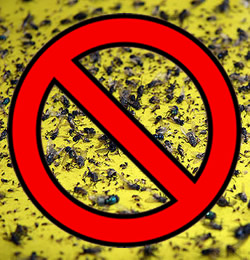I often receive emails asking advice on caring for a sick, injured, or baby bird. I offer what advice I can and also suggest they contact their local wildlife rehabilitation center or wildlife official. There are a plethora of reasons birds get into these conditions but this email was unusual. The bird, a Dark-eyed Junco, was caught in a sticky trip. To free it, the rescuers had to remove most of the bird’s feathers. This was a sticky trap used for mice but they are also used to capture pest insects. Unfortunately, there are a variety of sticky traps including glue boards that indiscriminately and inhumanely trap all kinds of creatures.

For centuries, glue traps, often made with bird lime as the glue, were used to capture songbirds across the world. For centuries, people around the world have caught birds by trapping them on branches smeared with bird lime. This method of hunting, popular in Europe for centuries, is considered brutal and traps multiple species beyond the sought-after thrushes and blackbirds for the dinner table.
Recently (October 2022) French hunters are no longer allowed to use the traditional technique for trapping wild birds with glue, Europe’s highest court ruled. Banned everywhere else in Europe, five jurisdictions of France held that they had the right to continue this traditional form of bird hunting but the European Court of Justice concluded Wednesday that the traps do “irreparable harm” to a large number of birds”.
Malta is a stopping-off point for some 170 species of birds migrating between Europe and Africa. But poachers kill thousands of wild birds every year — a problem widespread across the Mediterranean. Illegal trapping of birds such as finches continues persists in Malta, despite the law protecting songbirds. To justify bird trapping within the framework of European law, Malta claimed that finch trapping was a traditional practice in the country. Such legal manuevers are used as a smokescreen to illegally trap finches and other protected species but in other European countries
Using glue-sticks, mist nets and electronic calling devices to lure birds to a sticky death has been illegal in Cyprus since 1974. The law – at both EU and Cyprus level – clearly states that it is illegal to trap wild birds, to trade in them or put them on a restaurant menu. It is also illegal to eat ambelopoulia, a traditional dish of songbirds.
Trapping with glue is illegal because the catch is indiscriminate. If you shoot birds with a gun, you can limit both the number and identity of what ends up in your hunting bag. Shooting can be sustainable. Not so with limesticks: there is no way to control how many or what species end up dead.
In the U.S. I’m not aware that anyone has ever used glue to purposely capture birds in the past. But in the country’s early years, songbirds were killed by the thousands and shipped to restaurants on the east coast. They were shot, not glued, as if that makes a difference.
(I have purposely not illustrated this blog with a photo of a bird in a sticky trap; I find the photos unsettling.)
Almost inevitably, when one uses the “tradition” defense, it’s because they lack sound reasons for continuing an otherwise indefensible practice.
Thank you for this article. I have long been against glue traps of any kind. They are immoral. We need them banned in every way.